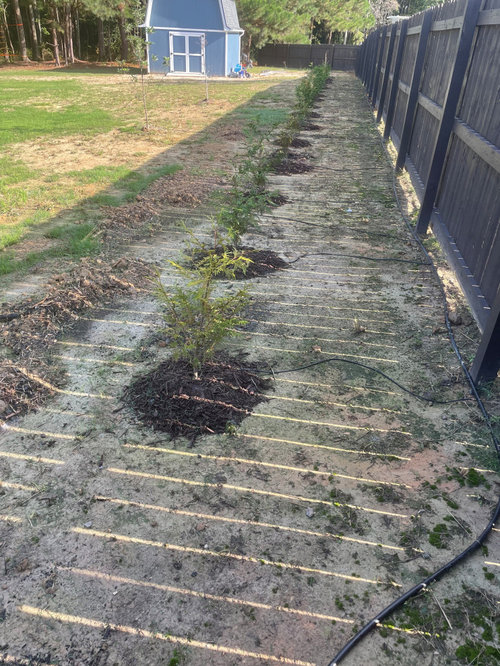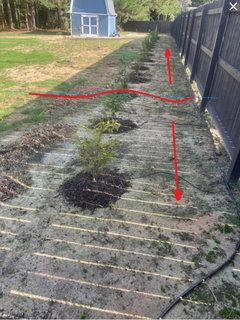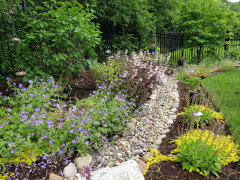How to stop water drainage from nieghbors property?
During rainstorms here in NC an incredible amount of water flows into my property from the adjoining neighbors yard. With the soil being heavy clay there is not much to slow it down causing the water to erode the soil on my property, wash away any attempt at seeding for grass, flushes out all nutrients and drowns my trees. I have pondered digging an 8-12in deep by 6-8inch wide ditch down the fence line then laying down heavy plastic and lastly filling with gravel such as crush N run. Any other ideas out there? If this is the appropriate route, will landscape fabric be a better choice than plastic and why? I'm also concerned with longevity of this approach as the amount of water would be sure to erode the side of the ditch. Thank you in advance.

Comments (10)
tsugajunkie z5 SE WI ♱
2 years agoYou might want to contact your local Soil and Water Conservation District for Stormwater Solutions.
tj
3onthetree
2 years agoFrom the debris piles it looks like the sheetflow (surface water runoff) is consistent along the fence - that's a good thing in that it doesn't appear the neighbor is causing extra harm in dumping water at point loads (like a pipe) than what would naturally occur down a slope.
Your idea of a 8" wide x 8" deep "ditch" is correct in concept just with some tweaking. You can create a swale along the fence, which compared to a "ditch" is considered less steep and doesn't come to a "vee" point. You then slope it to direct the sheetflow water to front or back, or to a retention area out of the way if there is no where for the water to drain offsite. Ground cover, no need for gravel. If you also have excessive underground water which is affecting something nearby, then you can install a french drain at the bottom of the swale to direct that water as well.
You can use the spoils from digging the swale to build a berm for the landscaping, which will simultaneouslly help in creating the swale and keep your plantings well drained. Especially since you might need to raise the plantings higher from the clay soil anyway (if clay hardpan vs clayey soil) and try not to make mulch volcanoes.

james7607
Original Author2 years agoI appreciate the input! I like the idea of the swale and french drain. the trees have been replanted to about 1-3 inches higher than the surrounding soil utilize pure clay with a 3"x24" shallow hole. The 1st attempt of 6-8inches deep and double root ball wide with bagged topsoil from lowes substituted for the clay was a massive failure and caused root rot on the GG's. The 2nd attempt of a deeper hole, 3 inches of pea gravel for drainage and pure bagged top soil furthered the root rot. They are now perc'd back up and back to green, for the most part. Now i need some help with water runoff before next rainy season.
kevin9408
2 years ago"Drainage Law in North Carolina is based on Common Law and court precedent. The law states that the person on the lower estate must receive and pass the water from the higher estate(s). Also, specific statutes prohibit the blockage of streams, drainageways and easements that remove water from higher elevations."
Just be careful how you pass the water to avoid problems. Laws addressing the natural flow of water are some of the oldest laws on the books for good reason, people killed each other over the issue. Plan wisely.
krnuttle
2 years agoThis is why he needs to understand the drainage in his neighborhood and not just in his yards.
A swale would do nothing if the down hill end of the swale is at the bottom the the slope in his side neighbor's yard. The swale has to complement the drainage in the neighborhood.dchall_san_antonio
2 years agoTo my eye this problem is for your neighbor to repair. He should not allow water to runoff of his property into the property of someone else. The easy fix for him is to mound up the soil on his side of the fence. Ideally you both would agree to removing the fence, building the mound where the fence stands, and replacing the fence on top of the mound. I've seen that done for a different reason. In this case the local rules limit fence height to 7 feet, so this guy built a 2-ft mound and built his fence 7 feet high on top of that.
Here is a picture taken in a neighborhood where it was designed right from the beginning.

The mounds and swales direct the water to the street for drainage. Water from behind the back wall drains into the pipe coming out into the gutter.
Van Zelst Inc
2 years agolast modified: 2 years agoYard areas with runoff and drainage issues can be challenging. Considering opportunities to improve drainage and to enhance the aesthetics of your property adjacent to your neighbor, there are a number of options.

These drainage concepts, such as swales, dry stream-beds, rain gardens, bioswales, and open french drains are all designed to accomplish 4 basic goals:- To move water from one area of the landscape to another
- To detain water in a designated area where it may be absorbed into the ground over a larger area
- To reduce maintenance related problems in an area of extreme moisture
- To look aesthetically pleasing and natural
Read our blog post for more helpful info about the essential elements of successful drainage: https://www.vanzelst.com/blog/water-problems-and-solutions/.Gator Grass Lawn Care
10 months agolast modified: 10 months agoSo I’m having a major problem with a North Carolina state owned drain pipe that has been diverted under the highway, I live on, straight into my yard. Overtime, this excess water that has ran through my yard and then under my house has rot the floor joist to the house from all the standing water. We never could figure out where it was coming from until today. If I understand the law right, this would fit under the “Civil Law Rule.”
Example ”The civil law rule states that if your neighbor changes the natural flow of water on their land in such a way that results in harm to another homeowner, then they may be held liable for any resulting harm. In other words, if the folks next door have installed any new landscaping or structures that change the way water flows on their property, then they could be held responsible for any damage to your property.”
The State of NC has changed the natural flow of the water and it harmed my house. Anyone disagree?
Thanks
nickel_kg